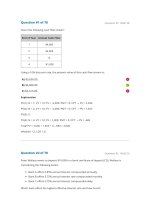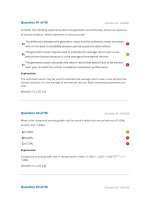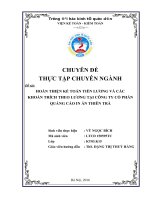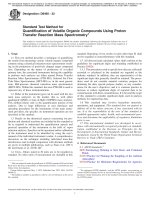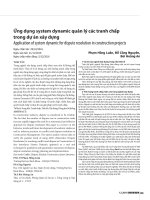Whole genome sequencing and taxonomic profiling of two Pantoea sp. isolated from environmental samples in Israel
Bạn đang xem bản rút gọn của tài liệu. Xem và tải ngay bản đầy đủ của tài liệu tại đây (948.77 KB, 4 trang )
(2022) 23:31
Guedj‑Dana et al. BMC Genomic Data
/>
BMC Genomic Data
Open Access
DATA NOTE
Whole genome sequencing and taxonomic
profiling of two Pantoea sp. isolated
from environmental samples in Israel
Yehoudit Guedj‑Dana, Inbar Cohen‑Gihon, Ofir Israeli, Ohad Shifman, Tamar Aminov, Shahar Rotem,
Raphael Ber and Anat Zvi*
Abstract
Objective: As part of a research aiming at the isolation of bacteria secreting growth inhibiting compounds, cultures
of Francisella tularensis were implanted in environmental samples and monitored for inhibition zones on agar. Two
antibiotic-like secreting bacteria were isolated, their genomic sequence was deciphered and taxonomic profiling
analysis classified them as belonging to the Pantoea genus.
Data description: Two bacterial isolates exhibiting growth inhibition zones to F. tularensis (LVS) were analyzed using
the Oxford Nanopore Technology (ONT). Preliminary de novo assembly of the reads was performed, followed by
taxonomic profiling based on Multi Locus Sequence Analysis (MLSA) and implementation of the Average Nucleo‑
tide Identity (ANI) measure. The genomic sequences resulted in the identification of two different Pantoea species,
denoted EnvD and EnvH.
Subsequent de novo genome assembly generated 5 and 10 contigs for EnvD and EnvH, respectively. The largest con‑
tig (4,008,183 bps and 3,740,753 bps for EnvD and EnvH, respectively), overlaps to a major extent to the chromosome
of closely related Pantoea species. ANI values calculated for both isolates revealed two apparently new species of the
Pantoea genus.
Our study deciphered the identity of two bacteria producing antibiotic-like compounds, and the genomic sequence
revealed they represent distinct Pantoea species.
Keywords: Pantoea, Environmental samples, Whole genome sequencing, Oxford nanopore, De novo assembly,
Taxonomy
Objective
Pantoea is a genus of Gram-negative bacteria belonging to the family Erwiniaceae. These bacteria were isolated from a multitude of environmental sources (such
as plants, animals, water, soil and human). They are distributed in nature, and over 25 species were already documented [1–4]. In this study we present the taxonomic
profiling of two environmental isolates which were identified by their ability to inhibit growth of F. tularensis
(LVS) colonies. The isolates were sequenced by long read
sequencing and assembled by a de novo assembly. We
calculated the ANI measure to establish the species relatedness and the MLSA method was implemented to generate a phylogenetic tree showing these variants as new
Pantoea species.
*Correspondence:
Department of Biochemistry and Molecular Genetics, Israel Institute
for Biological Research, Ness Ziona, Israel
© The Author(s) 2022. Open Access This article is licensed under a Creative Commons Attribution 4.0 International License, which
permits use, sharing, adaptation, distribution and reproduction in any medium or format, as long as you give appropriate credit to the
original author(s) and the source, provide a link to the Creative Commons licence, and indicate if changes were made. The images or
other third party material in this article are included in the article’s Creative Commons licence, unless indicated otherwise in a credit line
to the material. If material is not included in the article’s Creative Commons licence and your intended use is not permitted by statutory
regulation or exceeds the permitted use, you will need to obtain permission directly from the copyright holder. To view a copy of this
licence, visit http://creativecommons.org/licenses/by/4.0/. The Creative Commons Public Domain Dedication waiver (http://creativeco
mmons.org/publicdomain/zero/1.0/) applies to the data made available in this article, unless otherwise stated in a credit line to the data.
Guedj‑Dana et al. BMC Genomic Data
(2022) 23:31
Data description
In this study, over 20 environmental samples were collected from distinct different geographic locations in
Israel (natural sources). The samples were prepared by
wiping a 20 cm2 area of urban asphalt roads with 3 sterile cotton swabs (Copan Italia SPA) moistened aseptically in sterile phosphate-buffered saline (PBS) solution.
The swabs were discarded after extraction by vortex in
5 mL PBS. After 2 min. of passive sedimentation of dust
and dirt, 4.2 mL were transferred to new sterile tube.
An aliquot of 0.1 mL of each environmental sample was
mixed with 0.1 mL of PBS containing 108 cfu/ml of indicator bacteria (F. tularensis LVS), the mix was spread on
cysteine heart agar with hemoglobin (CHA, Difco), plates
were incubated for 2 days at 37 °C and monitored for
colonies demonstrating inhibition zone for the indicator strain. Several such colonies were further isolated to
pure cultures on CHA, and their inhibition to LVS was
verified. Two of the isolates showed differential capability
to grow in Brain Heart Infusion broth, and were denoted
herein as EnvD (from Talpiot industrial zone, Jerusalem) and EnvH (from Romema neighborhood, Haifa).
For DNA purification, EnvD and EnvH colonies were
grown on CHA, suspended to high density in 1 mL PBS,
mixed 1:1 with ATL buffer, heated at 100 °C for 30 min
before DNA purification using the QIAamp DNA blood
minikit (Qiagen). Whole genome sequencing was conducted in GenoHub facility (https://genohub.com) using
the Oxford Nanopore MinION Technology. Libraries
for both EnvD and EnvH were prepared using the SQKLSK109 ligation sequencing kit (Oxford Nanopore Technologies) and sequencing was conducted using an R9
flow cell. Basecalling was performed using Guppy v 4.4.2.
A total of 210,000 reads for EnvD (mean average length
of 3854 bps) and 190,000 reads for EnvH (mean average
length of 1881 bps) were obtained, resulting in a coverage
of 155x and 89x, respectively (data file 1) [5].
De novo assembly was conducted by implementing
Flye [6], designed for the assembly of long reads generated by ONT. Five contigs were obtained for EnvD, the
largest harboring a length of 4,008,183 bps, the N50
value being therefore 4,008,183. The EnvH generated
reads were assembled to a total of 10 contigs, the longest
being 3,740,753 bps (which is therefore the N50 value).
A rough and preliminary estimation of the taxonomical relatedness of the two isolates conducted by a Blast
analysis [7] against the nucleotide database (nt, https://
www.ncbi.nlm.nih.gov/nucleotide/), disclosed similarity to the Pantoea genus. Subsequently, the longest contig of each isolate was compared to all publicly available
Pantoea sequences (National Center for Biotechnology
Information, NCBI), revealing that the best matching
hits for EnvD and EnvH are Pantoea agglomerans and
Page 2 of 4
Pantoea stewartii, respectively. Accordingly, the contigs
generated by the assembly were aligned to their closest
species, using Mauve [8]. The alignments display a nearly
complete coverage of the reference chromosome by the
largest contig, both for EnvD and EnvH. In addition, two
of the remaining contigs overlap plasmid regions in the
reference genomes (data file 2) [9].
To further characterize whether the sequenced
genomes can be associated with one of the already known
Pantoea species, we used the ANI measure as a wellestablished whole genome similarity metrics [10–14]. The
ANI value was estimated using the FastANI algorithm
[12]. Pairwise ANI values of at most 82% were obtained
for each of the sequenced genomes with genomes representing known Pantoea species [15]. According to the
generally accepted cutoff value of 95% used as a boundary
for species delineation [14, 16], it appears that EnvD and
EnvH constitute new species within the Pantoea genus.
To note, the pairwise ANI value between EnvD and EnvH
is 83%, therefore representing two distinct lineages.
To assign the taxonomic profiling of the two isolates,
we implemented the Multi Locus Sequence Analysis
(MLSA) typing method, tailored for phylogeny analysis
of Pantoea species [17, 18], using five core genes that are
effective at species-level delineation of the genus Pantoea: fusA, gyrB, leuS, pyrG and rpoB [1]. The sequence of
the genes orthologous to EnvD and EnvH were extracted
from the contig sequences covering the chromosome
regions (contig 4 for EnvD and contig 3 for EnvH), and
concatenated into a mini-gene. Alongside, the five protein-coding genes were extracted from 37 representative,
reference and/or type strains of Pantoea and Tatumella
species (for a complete list of species included in the set
of 37 genomes, refer to [17]). The multiple alignment of
the 37 concatenated sequences together with the concatenated sequences originating from EnvD and EnvH
was constructed using the MAFFT algorithm (Multiple Alignment using fast Fourier Transform) [19] of the
MegAlign Pro (â19932020) (DNASTARđ). Phylogenetic analysis of the aligned sequences was conducted
using the PhyML tool [20], which estimates MaximumLikelihood phylogenies (NGPhylogeny.fr [21]). Each of
the new isolates, EnvD and EnvH, forms a distinct and
separate branch (data file 3) [22]. While EnvH is related
to Pantoea stewartii, Pantoea ananatis and Pantoea allii
species, EnvD is not only branching from a separate cluster, but is also relatively distant from species in this cluster (which includes, among others, Pantoea agglomerans,
corroborating with the preliminary assignment described
above for EnvD).
To conclude, two growth-inhibiting bacteria from environmental samples collected from two distinct areas in
Israel were identified and assigned as belonging to the
Guedj‑Dana et al. BMC Genomic Data
(2022) 23:31
Page 3 of 4
Table 1 Overview of data files/data sets
Label
Name of data file/data sets
File types (file extension)
Data repository and identifier (DOI or
accession number)
Data file 1 Sequencing and assembly metrics
Portable Document Format file (.pdf ) https://doi.org/10.6084/m9.figshare.15111765.v1
[5]
Data file 2 Alignment of contigs to a reference genome
Portable Document Format file (.pdf ) https://doi.org/10.6084/m9.figshare.15105198.v1
[9]
Data file 3 ANI values for Pantoea sp. EnvD and Pantoea
sp. EnvH
Portable Document Format file (.pdf ) https://doi.org/10.6084/m9.figshare.19204658.v2
[15]
Data file 4 Phylogenetics analyses
Portable Document Format file (.pdf ) https://doi.org/10.6084/m9.figshare.15111588.
v3 [22]
Data set 1 Sequencing reads of Pantoea sp. EnvD and
Pantoea sp. EnvH
Fastq file (.fastq.gz)
SRP316834 [23]
Data set 2 Genome assembly of Pantoea sp. EnvD
FASTA / GenBank / ASN.1
JAGTWO000000000.1 [24]
Data set 3 Genome assembly of Pantoea sp. EnvH
FASTA / GenBank / ASN.1
JAGTWN000000000.1 [25]
Pantoea genus. Their taxonomical profiling unveiled that
these bacteria can be classified as new Pantoea species
diverging from known Pantoea species described up to
date. Further experimental characterization of the mechanism involved in the LVS growth inhibition of these
Pantoea is now undertaken. Please see Table 1 for links to
Data files 1-4 and Data sets 1-3. 1.
Limitations
• The de novo assembly resulted in a number of contigs; while the longest contig very nearly cover the
chromosome region, some other regions of the EnvD
and EnvH sequenced genomes are fragmentally covered.
• By reason of practical considerations, the phylogeny
relatedness of the two Pantoea sp. EnvD and EnvH is
based on a limited dataset of 37 known Pantoea species, comprising of representative, reference and/or
type strains of Pantoea and Tatumella species.
Abbreviations
MLSA: Multi Locus Sequence Analysis; ANI: Average Nucleotide Identity; ONT:
Oxford Nanopore Technologies; MAFFT: Multiple Alignment using fast Fourier
Transform; PhyML: Phylogeny Maximum-Likelihood.
Acknowledgements
We thank Dr. Adi Beth-Din for fruitful discussions.
Authors’ contributions
YGD: analyzed the data and wrote the manuscript; ICG: analyzed the data;
OI: performed the sequencing and wrote the manuscript; OS: performed the
experiments; TA: performed the experiments; SR: performed the experiments
and helped in interpreting the results; RB: designed the experiments, super‑
vised the project and wrote the manuscript; AZ: supervised the bioinformatics
analyses and wrote the manuscript. All authors read and approved the final
manuscript.
Funding
This research received no external funding.
Availability of data and materials
Data files 1–4 described in this Data note can be freely and openly accessible
on Figshare (https://figshare.com/) [5, 9, 22]. Data sets 1–3 are available on
the NCBI database. The raw reads have been submitted to the NCBI Sequence
Read Archive under the accession number SRP316834 for Pantoea sp. EnvD
and Pantoea sp. EnvH (Data set 1) [23–25]. The genome assemblies of the two
samples were submitted to NCBI GenBank and are available under the acces‑
sion number JAGTWO000000000 for the Pantoea sp. EnvD and the accession
number JAGTWN000000000 for the Pantoea sp. EnvH (Data sets 2–3) [24, 25].
Declarations
Ethics approval and consent to participate
Not applicable.
Consent for publication
Not applicable.
Competing interests
The authors declare that they have no competing interests.
Received: 31 August 2021 Accepted: 6 April 2022
References
1. Tambong JT. Taxogenomics and systematics of the genus Pantoea. Front
Microbiol. 2019;10:2463.
2. Agarwal G, Choudhary D, Stice SP, MyersGitaitis BKRD, Venter SN, et al.
Pan-genome-wide analysis of Pantoea ananatis identified genes linked to
pathogenicity in onion. Front Microbiol. 2021;12:684756.
3. Agarwal G, Gitaitis RD, Dutta B. Pan-Genome of novel Pantoea stewartii
subsp indologenes reveals genes involved in onion pathogenicity and
evidence of lateral gene transfer. Microorganisms. 2021;9(8):1761.
4. Stice SP, Shin GY, De Armas S, Koirala S, Galvan GA, Siri MI, et al. The distri‑
bution of onion virulence gene clusters among Pantoea spp. Front Plant
Sci. 2021;12:643787.
5. Data file 1: Sequencing and assembly metrics. Figshare: https://doi.org/
10.6084/m9.figshare.15111765.v1 (2021).
Guedj‑Dana et al. BMC Genomic Data
(2022) 23:31
Page 4 of 4
6. Kolmogorov M, Bickhart DM, Behsaz B, Gurevich A, Rayko M, Shin SB,
et al. metaFlye: scalable long-read metagenome assembly using repeat
graphs. Nat Methods. 2020;17(11):1103–10.
7. Altschul SF, Gish W, Miller W, Myers EW, Lipman DJ. Basic local alignment
search tool. J Mol Biol. 1990;215(3):403–10.
8. Darling AC, Mau B, Blattner FR, Perna NT. Mauve: multiple alignment
of conserved genomic sequence with rearrangements. Genome Res.
2004;14(7):1394–403.
9. Data file 2: Alignment of contigs to a reference genome. Figshare: https://
doi.org/10.6084/m9.figshare.15105198.v1 (2021).
10. Figueras MJ, Beaz-Hidalgo R, Hossain MJ, Liles MR. Taxonomic affili‑
ation of new genomes should be verified using average nucleotide
identity and multilocus phylogenetic analysis. Genome Announc.
2014;2(6):e00927-14.
11. Arahal DR. Whole-genome analyses: Average Nucleotide Identity. Meth‑
ods in Microbiology. 2014;41:103–22.
12. Jain C, Rodriguez RL, Phillippy AM, Konstantinidis KT, Aluru S. High
throughput ANI analysis of 90K prokaryotic genomes reveals clear spe‑
cies boundaries. Nat Commun. 2018;9(1):5114.
13. Konstantinidis KT, Tiedje JM. Genomic insights that advance the species
definition for prokaryotes. Proc Natl Acad Sci U S A. 2005;102(7):2567–72.
14. Goris J, Konstantinidis KT, Klappenbach JA, Coenye T, Vandamme P,
Tiedje JM. DNA-DNA hybridization values and their relationship to
whole-genome sequence similarities. Int J Syst Evol Microbiol. 2007;57(Pt
1):81–91.
15. Data file 3: Table of ANI scores for Pantoea sp. EnvD and Pantoea sp. EnvH.
Figshare: https://doi.org/10.6084/m9.figshare.19204658.v2 (2022).
16. Richter M, Rossello-Mora R. Shifting the genomic gold standard
for the prokaryotic species definition. Proc Natl Acad Sci U S A.
2009;106(45):19126–31.
17. Tambong JT, Xu R, Kaneza CA, Nshogozabahizi JC. An in-depth analysis of
a multilocus phylogeny identifies leuS As a reliable phylogenetic marker
for the genus Pantoea. Evol Bioinform Online. 2014;10:115–25.
18. Deletoile A, Decre D, Courant S, Passet V, Audo J, Grimont P, et al.
Phylogeny and identification of Pantoea species and typing of Pantoea
agglomerans strains by multilocus gene sequencing. J Clin Microbiol.
2009;47(2):300–10.
19. Katoh K, Standley DM. MAFFT: iterative refinement and additional meth‑
ods. Methods Mol Biol. 2014;1079:131–46.
20 Guindon S, Dufayard JF, Lefort V, Anisimova M, Hordijk W, Gascuel O. New
algorithms and methods to estimate maximum-likelihood phylogenies:
assessing the performance of PhyML 3.0. Syst Biol. 2010;59(3):307–21.
21 Lemoine F, Correia D, Lefort V, Doppelt-Azeroual O, Mareuil F, CohenBoulakia S, et al. NGPhylogeny.fr: new generation phylogenetic services
for non-specialists. Nucleic Acids Res. 2019;47(W1):W260–5.
22. Data file 4: Phylogenetics analyses. Figshare: https://doi.org/10.6084/m9.
figshare.15111588.v3 (2021).
23. National Center for Biotechnology Information. Sequence Read Archive.
https://trace.ncbi.nlm.nih.gov/Traces/sra/?study=SRP316834 (2021).
24. National Center for Biotechnology Information. Assembly. https://www.
ncbi.nlm.nih.gov/Traces/wgs/JAGTWO01?display=contigs (2021).
25. National Center for Biotechnology Information. Assembly. https://www.
ncbi.nlm.nih.gov/Traces/wgs/JAGTWN01?display=contigs (2021).
Publisher’s Note
Springer Nature remains neutral with regard to jurisdictional claims in pub‑
lished maps and institutional affiliations.
Ready to submit your research ? Choose BMC and benefit from:
• fast, convenient online submission
• thorough peer review by experienced researchers in your field
• rapid publication on acceptance
• support for research data, including large and complex data types
• gold Open Access which fosters wider collaboration and increased citations
• maximum visibility for your research: over 100M website views per year
At BMC, research is always in progress.
Learn more biomedcentral.com/submissions
